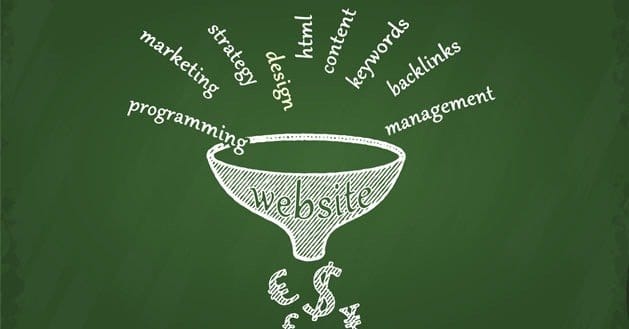 Written by ContentPowered.com
Written by ContentPowered.com
When you picture a funnel, you’re picturing a particular shape, a three-dimensional inverse pyramid, open-mouthed and narrow-necked. This shape is ideal for pouring liquid with minimal spillage, but it’s also a good representation of the typical business model.
A sales funnel begins with the broadest possible audience; everyone, ever. Each successive step down in the funnel is narrower, with a more selective audience, leading to the following step. The audience of everyone becomes the audience of Facebook users. The audience of Facebook users becomes the audience of Facebook users potentially interested in your product. That interested audience becomes people who follow you, which becomes people who see your posts, which becomes people who click your links.
Each step of the way, it’s only a small percentage of the larger audience above, but that smaller audience is successively more valuable than the last. At the end, you have the distilled drip-feed of people buying your products, subscribing to your services, and advocating you to everyone they know.
1. Establish a Facebook Presence
There’s a lot to this step, and countless articles and ebooks have been written with the topic in mind. It covers everything from setting up your account to gathering an audience.
The first part is to set up an account, a Page, and all the information that goes with it. If you already have this, good. If you don’t, you have a lot of work to do before you’re at all likely to start bringing in sales from your Facebook page.
The next step is to do what you can to grow a basic audience. Publish some content, run some advertising, mention your page in your mailing list, promote it on your website, and so forth. You need at least a basic audience to begin expansion.
This is also the point where you need to establish a social media team and their various roles. Who creates the content, who monitors Insights, who organizes the content calendar, who uses Power Editor and the other tools available to Facebook marketers? Depending on the size and scale of your marketing efforts, this may all be the responsibility of one person, or it may be that of a large team working in conjunction.
2. Establish a Sales Path
Once everything is established, you need to determine your ideal sales path. For example, pulling a user from Facebook to your website landing page, convincing them to sign up for your mailing list, pushing mailing list sales pitches to get them to your product page, and selling the product, all may be one viable sales path. Establish several paths; an ideal, a typical estimation, an actual measured path, and so forth.
At each step of the sales path, determine which key performance metrics can be used to measure success. For the first step, gathering interested users, you might use post engagement, ad reach, ad impressions, or number of clicks. Later on down the funnel, you might use conversion rate and raw profits as valid metrics. These metrics will be useful later.
3. Push Content and Ads for Visibility
Once your metrics are established, it’s time to start the funnel in earnest. Ramp up your content efforts, run deep ad campaigns, and generally do as much as you can to start drawing people into your funnel. In the introduction, I talk about the widest audience of all possible people, and the narrower audience of people on Facebook, and the narrower still audience of people with interests that align with your brand.
This step is where you do as much as you can to get the first two audiences to become the third. You need to gather up as many people as possible to view and click your ads, or to follow your Facebook page and engage with your content.
The caveat to this is that you really, really need to make sure your fans are relevant. You can’t just grab 10,000 people off the street in India and make them follow your page; they do nothing for you. You need to make sure the people you attract are the types of people who will buy your product. Otherwise, your funnel is clogged.
4. Interact with Users for Engagement
The next stage of the funnel is narrower still, and it’s getting those interested people to engage with your brand. Typical engagement rates on Facebook through natural posts are less than 5%. Depending on how you measure them, they might only be closer to 1%, or even less.
This is perhaps one of the most abrupt declines in your audience size from step to step in your entire funnel. Most other metrics – reach, conversion rate – will be significantly higher than 1%. Therefore, it’s important to do as much as you possibly can to increase your engagement rate.
5. Push Sales Off-Site
Facebook does have a few methods through tab apps to allow you to sell directly through the platform. Some businesses can even be successful in this method. Chances are, you’re not one of them. It’s much better to take the time to draw users off-site and lay down the heavy sales talk. Facebook has rules against overt sales language in posts, and will be enforcing them more and more heavily as 2015 progresses.
The best way to do this off-site sales is through a mailing list dedicated to lead generation and nurturing. That said, you can also find some success through sales calls, paper mailers and other forms of targeted off-site advertising. Regardless of the sales path, make sure you have metrics in place to measure it.
6. Monitor Performance Metrics
Successful sales funnels measure a lot of data. I mean a lot. You would be surprised at the sheer amount of data they measure. It’s your goal to measure this data yourself, so you know where the strong points and the weak points in your funnel may be.
All of this data means nothing, however, unless you:
7. Iterate, Test, Iterate
Successful funnels are never static. It may work, but working isn’t good enough. Everything needs to be improving. Every step of the way, every measurable metric, you need to be segmenting your audience, crafting experiments, testing alternatives and streamlining your process. Test a method. If it works, implement it and iterate new tests. If it doesn’t, perform new tests on the old, better method. Keep this up on an ongoing basis.


